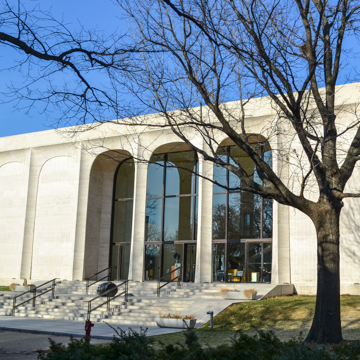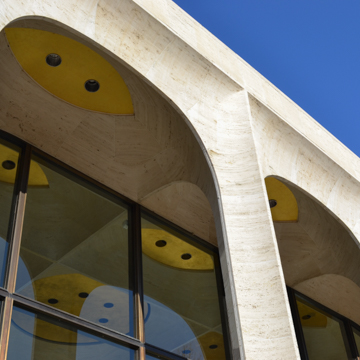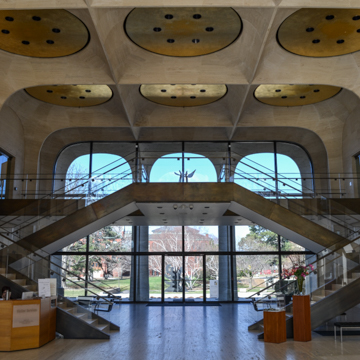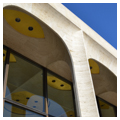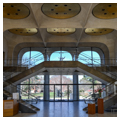You are here
Sheldon Museum of Art
A gift of the Sheldon family established this museum with the stipulation that an architect of international reputation design the building. The competition included proposals from such leading modernists as Marcel Breuer and Richard Neutra. Philip Johnson’s winning scheme was a dramatic departure from his earlier embrace of the International Style and, exhibits historical references that draw on his original designs for the New York State Theater at Lincoln Center and the Lake Pavilion at his estate in New Canaan. The Sheldon Museum was dedicated in 1963, with Philip Johnson speaking at the ceremony.
Set on a plinth, like a classical temple, the museum is at the center of University of Nebraska-Lincoln’s city campus. The rectangular two-story building is divided into three elements of equal size and is constructed of reinforced concrete. The opaque end portions house various-sized galleries, offices, and a 300-seat auditorium, and bookend the spacious thirty-foot-high Great Hall with tall glass facades that provide views out to the campus on the east and west. The basement contains storage, workspaces, and service and mechanical areas.
The essence of the building, according to Johnson, was its splayed columns, subtly tapered and curving members crowned by elliptical arches. These gracefully protrude from the wall surfaces as pilasters and are dramatically revealed as in-the-round sculptural elements at the center of the east and west facades, acting as a threshold into the Great Hall. The exterior wall surfaces are white Italian travertine, as are the interior walls and ceilings of the Great Hall. This focal point of the building has clearly articulated ceiling divisions that are emphasized by large circular recessed panels covered with gold leaf. The Great Hall, the site of many social events, also features a prominent double stair and bridge that provides access to and connects the second floor galleries. The museum’s permanent collection has over 12,000 objects of American art.
The Sculpture Garden was dedicated in 1970. Designed by Caudill Rowlett Scott of Houston, it includes important works from the early twentieth century to the present. Originally it occupied only two-and-a-half acres adjacent to the museum but has expanded since then. Today sculpture is installed across the University of Nebraska-Lincoln City and East campuses.
References
Gengler, Melissa Dirr, and Greg Munn, “Sheldon Memorial Art Gallery,” Lancaster County, Nebraska. National Register of Historic Places Registration Form, 2013. National Park Service, U.S. Department of the Interior, Washington, DC. http://www.nebraskahistory.org/histpres/nebraska/lancaster/LC13-C09-008Sheldon.pdf.
Janovy, Karen O. Sculpture from the Sheldon Memorial Art Gallery. Lincoln, NE: University of Nebraska Press, 2005.
Schulze, Franze. Philip Johnson: Life and Work. Chicago, IL: University of Chicago Press, 1996.
Writing Credits
If SAH Archipedia has been useful to you, please consider supporting it.
SAH Archipedia tells the story of the United States through its buildings, landscapes, and cities. This freely available resource empowers the public with authoritative knowledge that deepens their understanding and appreciation of the built environment. But the Society of Architectural Historians, which created SAH Archipedia with University of Virginia Press, needs your support to maintain the high-caliber research, writing, photography, cartography, editing, design, and programming that make SAH Archipedia a trusted online resource available to all who value the history of place, heritage tourism, and learning.














